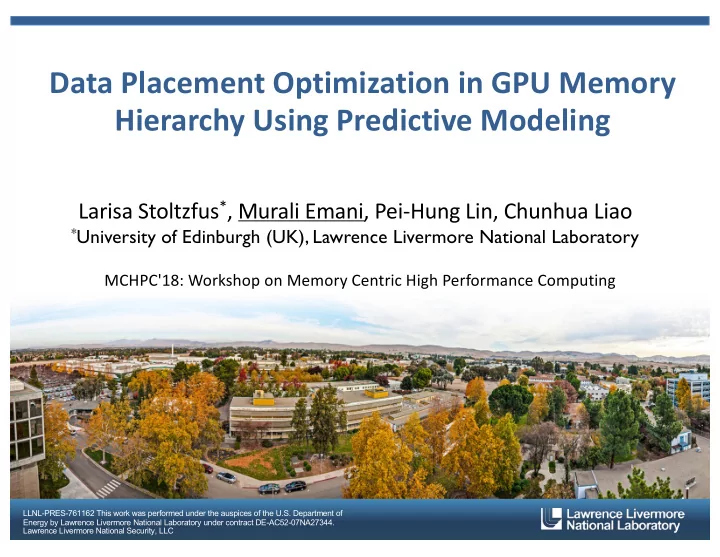

Data Placement Optimization in GPU Memory Hierarchy Using Predictive Modeling Larisa Stoltzfus * , Murali Emani, Pei-Hung Lin, Chunhua Liao * University of Edinburgh (UK), Lawrence Livermore National Laboratory MCHPC'18: Workshop on Memory Centric High Performance Computing LLNL-PRES-761162 This work was performed under the auspices of the U.S. Department of Energy by Lawrence Livermore National Laboratory under contract DE-AC52-07NA27344. Lawrence Livermore National Security, LLC
Complex Memory Hierarchy on GPUs § GPUs can greatly improve performance of HPC applications, but can be difficult to optimize for due to their complex memory hierarchy § Memory hierarchies can change drastically from generation to generation § Codes optimized for one platform may not retain optimal performance when ported to other platforms 2 LLNL-PRES-761162
Performance can vary widely depending on data placement as well as platform Kepler Maxwell Pascal Volta 4 3 Matrix-Matrix Multiplication Speedup 2 1 0 1234567 1234567 1234567 1234567 Kepler Maxwell Pascal Volta Sparse Matrix-Vector 1.5 Multiplication Speedup 1.0 0.5 0.0 123456789 123456789 123456789 123456789 Memory Type [ Platform ] 3 LLNL-PRES-761162
Challenges § Different memory variants (global/ constant/ texture/ shared) can have significant impact on program performance § But identifying the best performing variant is non-obvious and complex decision to make § Given a default global variant, can the best performing memory variant be automatically determined? 4 LLNL-PRES-761162
Proposed Solution § Use machine learning to develop a predictive model to determine the best data placement for a given application on a particular platform § Use the model to predict best placement § Involves three stages: — offline training — feature and model selection — online inference 5 LLNL-PRES-761162
Approach Offline training Online inference global shared constant texture Representative kernels program variants Training Data collection Use nvprof, HW info Offline Training - Data collection Feature Feature Extraction extraction using and labelling of nvprof metrics and events CUPTI Training data Classifier Classifier best variant 6 LLNL-PRES-761162
Approach Offline training Online inference global shared constant texture Representative kernels program variants Training Data collection Use nvprof, HW info Model Building - Determine Feature Feature Extraction extraction using and labelling best version, features and model CUPTI Training data Classifier Classifier best variant 7 LLNL-PRES-761162
Approach Offline training Online inference global shared constant texture Representative kernels program variants Training Data collection Use nvprof, HW info Online Inference: Use Feature Feature Extraction model to determine best extraction using and labelling CUPTI placement in run-time Training data Classifier Classifier best variant 8 LLNL-PRES-761162
Methodology In order to build the model: § 4 different generations of NVIDIA GPUs were used: — Kepler — Pascal — Maxwell — Volta § 8 programs X 3 input data sizes X 3 thread block sizes X 4 variants MD, SPMV, CFD, MM, ConvolutionSeparable, ParticleFilter etc. 9 LLNL-PRES-761162
Offline Training § Metric and event data from nvprof from global variant along with hardware data were collected § Best performing variant (class label) for each version run was appended § Benchmarks were run 10 times on each platform, with 5 initial iterations to warm up the GPU 10 LLNL-PRES-761162
Feature Selection § Number of features narrowed down to 16 from 241 using correlation-based feature selection algorithm (CFS). § A partial list: Feature Name Meaning achieved_occupancy ratio of average active warps to maximum number of warps l2_read_transactions, Memory read/write transactions at L2 l2_write_transactions cache gld_throughput global memory load throughput warp_execution_efficiency ratio of average active threads to the maximum number of threads 11 LLNL-PRES-761162
Model Selection § Used 10-fold cross validation during evaluation § Overall, decision tree classifiers showed great promise (>95% accuracy in prediction) Classifier Prediction Accuracy (%) RandomForest 95.7 LogitBoost 95.5 IterativeClassifierOptimizer 95.5 SimpleLogistic 95.4 JRip 95.0 12 LLNL-PRES-761162
Runtime Prediction § The classifier JRIP was selected from the group of top five performing classifier models § JRIP is a propositional rule learner, which results in a decision tree § The model then reads in input from CUPTI calls - the API for nvprof - which can access hardware counters in real-time and outputs its class 13 LLNL-PRES-761162
Preliminary Results texture constant shared global 100 75 % Predicted 50 25 0 t l d e n a r e b a r u t o a t s x l h n g e s o t c Memory Type • Results from this initial exploration show that there is great potential for predictive modeling for data placement on GPUs • Overall 95% accuracy achievable, but this is higher for global and texture memory best performers 14 LLNL-PRES-761162
Runtime Validation § The JRIP model was tested out on a new benchmark - an acoustic application § The model was successfully able to correctly predict the best performing version on two platforms 15 LLNL-PRES-761162
Limitations § Currently, all versions need to be pre-compiled for run-time prediction, ideally it would be better to have model built into a compiler § CUPTI calls are slow and require as many iterations as metrics and events to collect § This would acceptable for benchmarks with many iterations, but for other kinds a workaround would need to be made 16 LLNL-PRES-761162
Conclusion § Machine learning has shown great potential for data placement prediction on a range of applications § More work needs to be done to acquire hardware counters from applications in a timely manner § Approach could be reused for other optimizations such as data layouts. 17 LLNL-PRES-761162
19 LLNL-PRES-761162
Recommend
More recommend